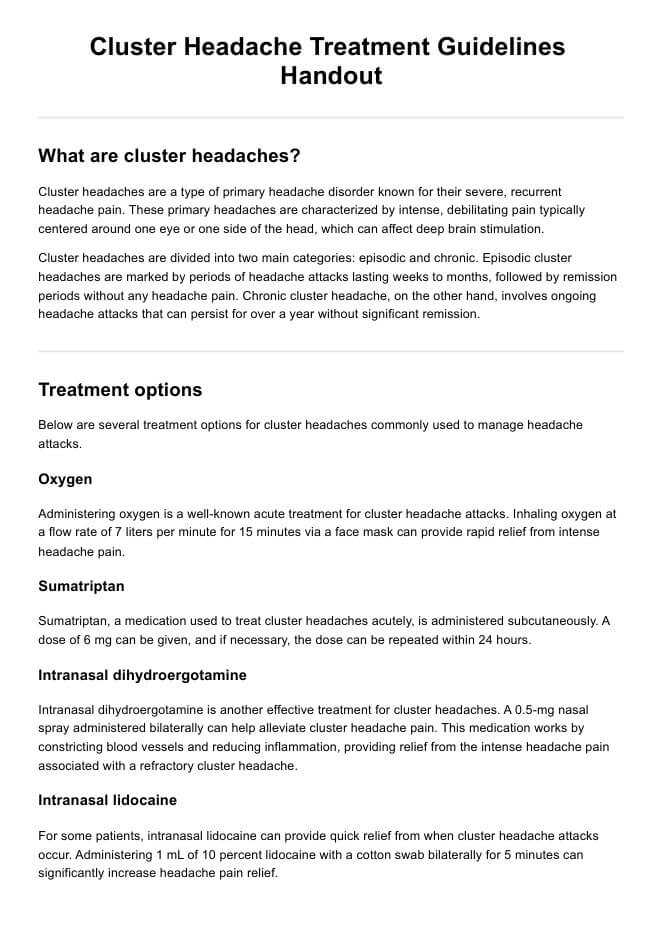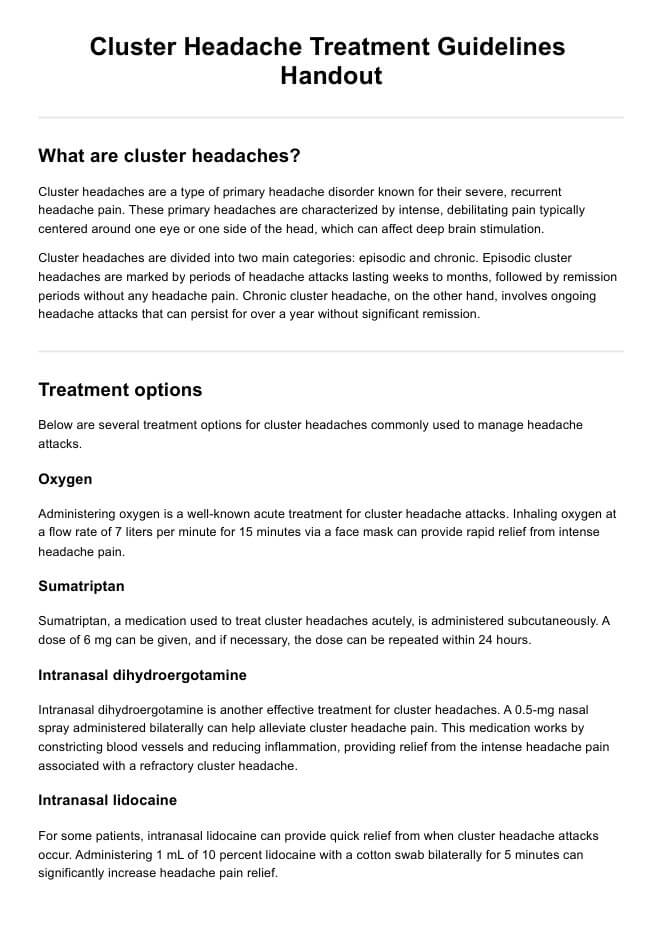Cluster Headache Treatment Guidelines Handout
Access Carepatron's free PDF download of cluster headache treatment guidelines to effectively manage and treat cluster headaches.


What are cluster headaches?
Cluster headaches are a type of primary headache disorder known for their severe, recurrent headache pain. These primary headaches are characterized by intense, debilitating pain typically centered around one eye or one side of the head, which can affect deep brain stimulation.
Cluster headaches are divided into two main categories: episodic cluster headache and chronic cluster headache. Episodic cluster headaches are marked by periods of headache attacks lasting from weeks to months, followed by remission periods without any headache pain. Chronic cluster headache, on the other hand, involves ongoing headache attacks that can persist for over a year without significant remission.
The exact cause of cluster headaches remains unclear, but they are believed to be related to the hypothalamus, a region in the brain responsible for regulating biological rhythms. Various triggers such as alcohol, strong smells, and certain medications can provoke cluster headache attacks. Cluster headache symptoms often include severe headache pain, nasal congestion, watery eyes, and facial sweating. The attacks can be so intense that they are sometimes referred to as acute cluster headache.
Diagnosing a intractable chronic cluster headache typically involves a thorough medical history and examination. Healthcare practitioners might consider diagnostic criteria, although a detailed discussion of these criteria is beyond the scope of this overview. The diagnosis process ensures that the appropriate treatment of cluster headache is implemented, which can include both acute treatment for immediate relief and preventive strategies.
Cluster Headache Treatment Guidelines Handout Template
Cluster Headache Treatment Guidelines Handout Sample
How to manage and treat cluster headaches
Managing and treating headaches effectively requires a multifaceted approach tailored to the severity and frequency of the attacks. Treatments aim to alleviate the intense cluster headache discomfort during an episode and prevent future attacks.
Below are several treatment of cluster headache options commonly used to manage headache attacks.
Oxygen
Administering oxygen is a well-known acute treatment for cluster headache attacks. Inhaling oxygen at a flow rate of 7 liters per minute for 15 minutes via a face mask can provide rapid relief from the intense headache pain.
Sumatriptan
Sumatriptan, a medication used in the acute treatment of cluster headaches, is administered subcutaneously. A dose of 6 mg can be given, with the option to repeat the dose within 24 hours if necessary.
Intranasal dihydroergotamine
Intranasal dihydroergotamine is another effective treatment for cluster headaches. A 0.5-mg nasal spray administered bilaterally can help alleviate cluster headache pain. This medication works by constricting blood vessels and reducing inflammation, providing relief from the intense headache pain associated with a refractory cluster headache.
Intranasal lidocaine
For some patients, intranasal lidocaine can provide quick relief from when cluster headache attacks occur. Administering 1 mL of 10 percent lidocaine with a cotton swab bilaterally for 5 minutes can significantly increase headache pain relief.
Intranasal capsaicin
Intranasal capsaicin, derived from chili peppers, is an innovative treatment for cluster headaches. Placing capsaicin via a cotton swab in the ipsilateral nostril twice a day for seven days can help alleviate headache disorders.
What is a Cluster Headache Treatment Guidelines Handout?
A Cluster Headache Treatment Guidelines Handout is a comprehensive resource designed to assist healthcare professionals in managing patients diagnosed with cluster headaches. The handout includes detailed information on cluster headache treatment options.
Healthcare professionals, including neurologists, primary care physicians, and pain specialists, can utilize this handout to provide complete pain relief for their patients. It is especially beneficial when dealing with cases of sleep apnea, which can trigger cluster headaches. The handout can be used during consultations to educate patients about their condition and discuss effective treatment options.
How to use our treatment guidelines handout template?
Using Carepatron's Cluster Headache Treatment Guidelines Handout can streamline the process of managing and treating cluster headaches for healthcare professionals. This handout serves as a valuable tool to ensure comprehensive care and patient education. Here’s how to effectively use this resource:
Access and download the handout
First, access the Cluster Headache Treatment Guidelines Handout through Carepatron’s Resource Library. Download the document to your computer or device.
Review the handout
Take the time to thoroughly review the handout. Familiarize yourself with the treatment guidelines This will enable you to provide informed and accurate guidance to your patients.
Educate the patient/family of the patient with the handout
During consultations, use the handout to educate patients and their families about cluster headaches. Explain the symptoms, such as unilateral headache and stabbing pain, and discuss various treatment options. Ensure that patients understand both acute and preventive treatments to achieve complete pain relief. This step is crucial for patient empowerment and involvement in their own care.
Monitor progress and do follow-ups
Use the handout as a reference to monitor patient progress over time. Schedule regular follow-ups to assess the effectiveness of the treatment plan and make necessary adjustments. Keeping track of patient responses to treatments can help in identifying the most effective strategies and ensure ongoing management of chronic cluster headaches.
Benefits of using this handout
This handout serves as a centralized resource, providing concise and accurate information on the management of episodic cluster headache and other trigeminal autonomic cephalalgias. Healthcare providers can use the handout to educate patients about various treatment options, including noninvasive vagus nerve stimulation and prophylactic treatments.
For patients, the handout offers clarity on the clinical features and triggers of cluster headaches, empowering them to participate actively in their treatment plans. By understanding preventive strategies and acute treatment options detailed in the handout, patients can better manage their condition and seek timely medical assistance when needed.
Commonly asked questions
The first line of a management of cluster headache typically includes acute medications such as triptans (like sumatriptan) and high-flow oxygen therapy to relieve pain quickly and effectively.
An intractable cluster headache can last from 15 minutes to 3 hours, occurring up to multiple times a day during a cluster period, which can last weeks to months.
In the emergency room, cluster headache treatment may involve administering oxygen therapy, intravenous medications like dihydroergotamine or corticosteroids, and assessing for any complications or need for further intervention.
The exact cause of cluster headaches is not fully understood, but they are believed to involve abnormalities in the hypothalamus and trigeminal nerve, as well as changes in neurotransmitter levels.







































































































